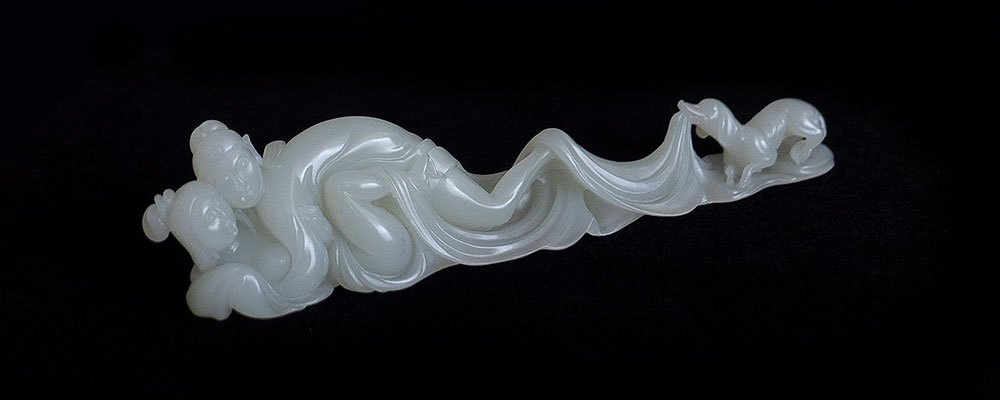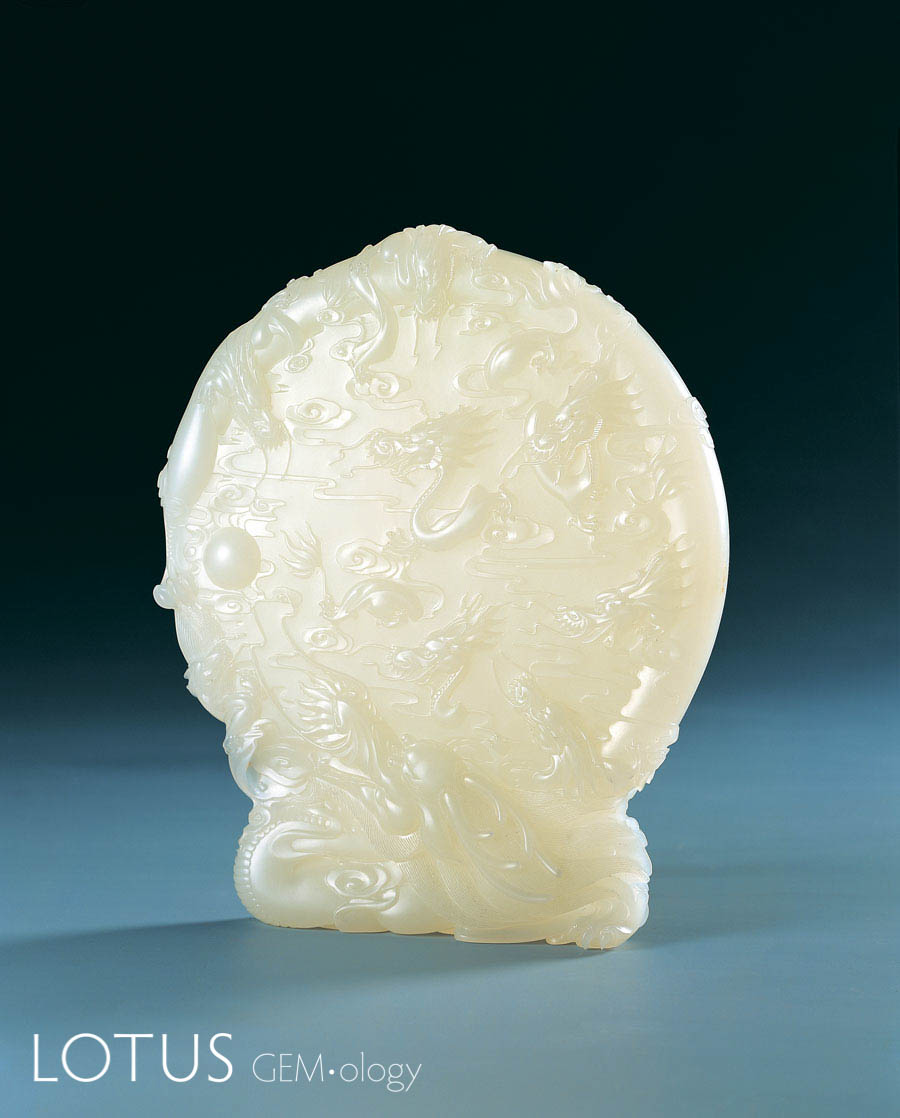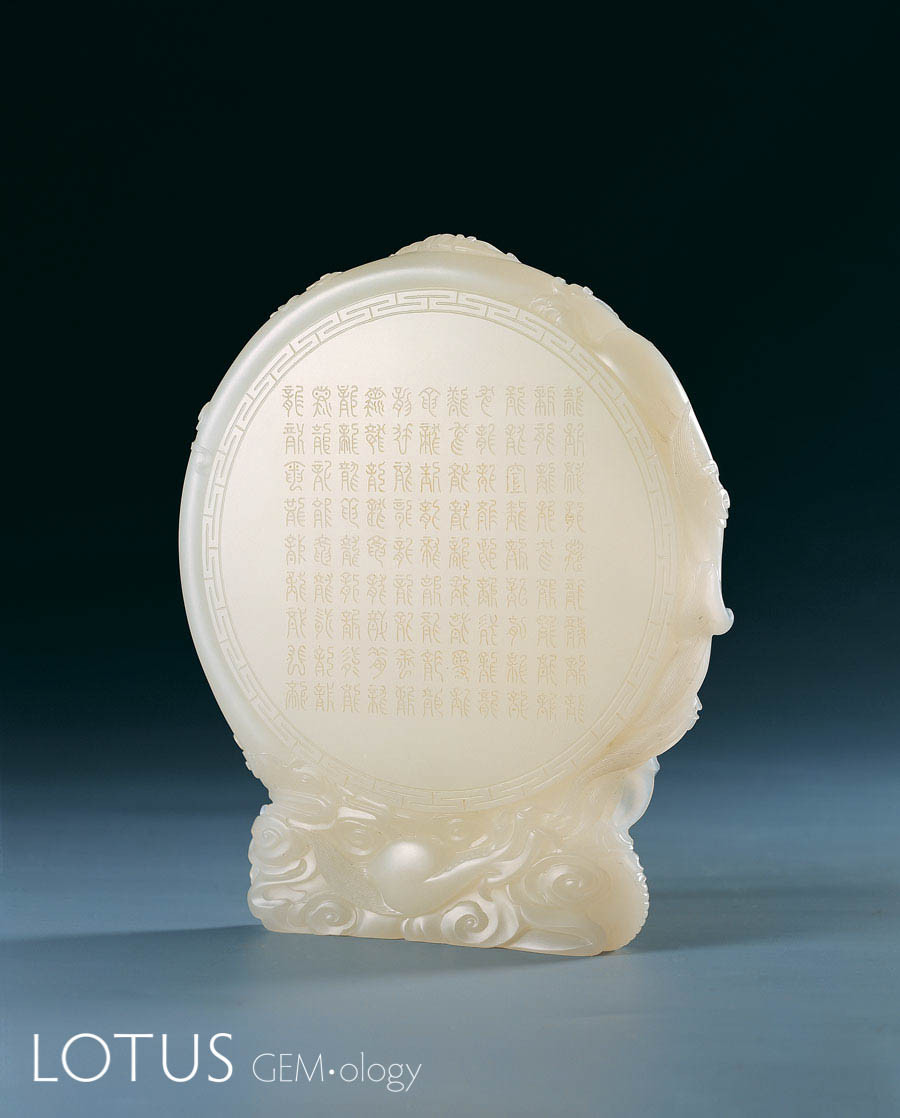The word "jade" often evokes the green jadeite used in jewelry. However, some of the most valuable jade in China is not this green jadeite, but in the creamy "mutton fat" carved nephrite from Hetian, Xinjiang province. In the past, many carvings touched upon familiar motifs like dragons or religious symbols, while in recent decades there has been a revolution of carving, with artists incorporating modern themes and styles into their work. Lin Tze-Chuan, an influential collector and patron of many jade carvers, is considered by many to be the father of Chinese contemporary jade carving. Here he discusses the changing world of jade carving and what he looks for when commissioning new work.
Contemporary Jade Carving in China •Interview with Lin Tze-Chuan
E. Billie Hughes—Can you tell us about yourself and your background?
LIN TZE-CHUAN (Lin Zi Quan)—I was born in Keelung, Taiwan, in 1959. My first company , Taipei Guanxitang, was founded in 1989. I came to Shanghai in 1993 to create contemporary white jade art, and founded Shanghai Guanxitang in 2004. A third company, Beijing Guanxitang, was established in 2011. (Guanxitang roughly translates to 'we will feel a sense of joy when we see beautiful jade')
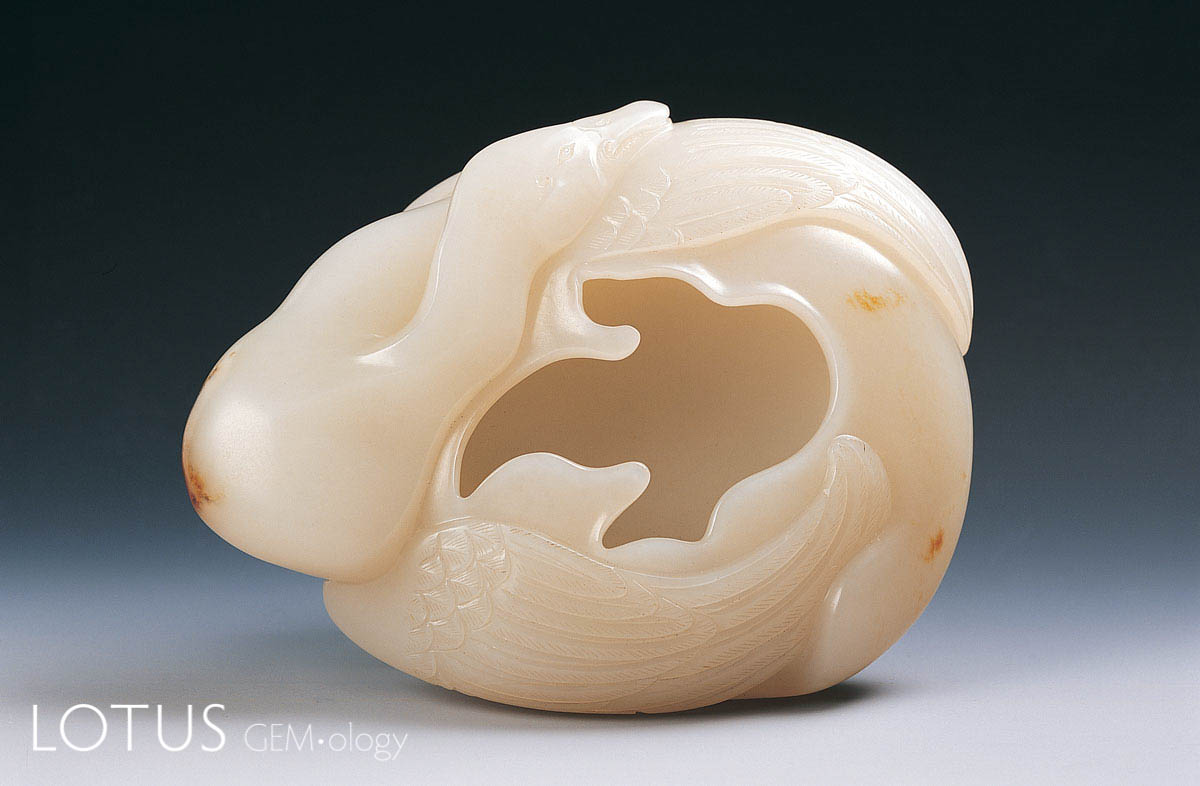 Water pan by Yu Jing with a cloud pattern and a Gyrfalcon at the edge. Hetian "mutton fat" nephrite from Xinjiang, China. 9.9 x 7.5 x 2.9 cm; 1998. Photo: Zou Liu. Click on the photo for a larger image
Water pan by Yu Jing with a cloud pattern and a Gyrfalcon at the edge. Hetian "mutton fat" nephrite from Xinjiang, China. 9.9 x 7.5 x 2.9 cm; 1998. Photo: Zou Liu. Click on the photo for a larger image
EBH—How did you first become interested in jade?
LTC—Since 1988, I have been dealing with miscellaneous antiques and ancient jades. At that time, I was interested in the decorative patterns of ancient jades. I think such patterns have unique cultural connotations and mysterious meanings. Later, as I began to specialise in ancient jades, I gained more understanding of their shapes, decorative patterns and colours.
Because the sources of ancient jade are not fully understood, and the authenticity of many ancient jades cannot be authoritatively certified, since 1993, the scope of my business gradually shifted to modern jade.
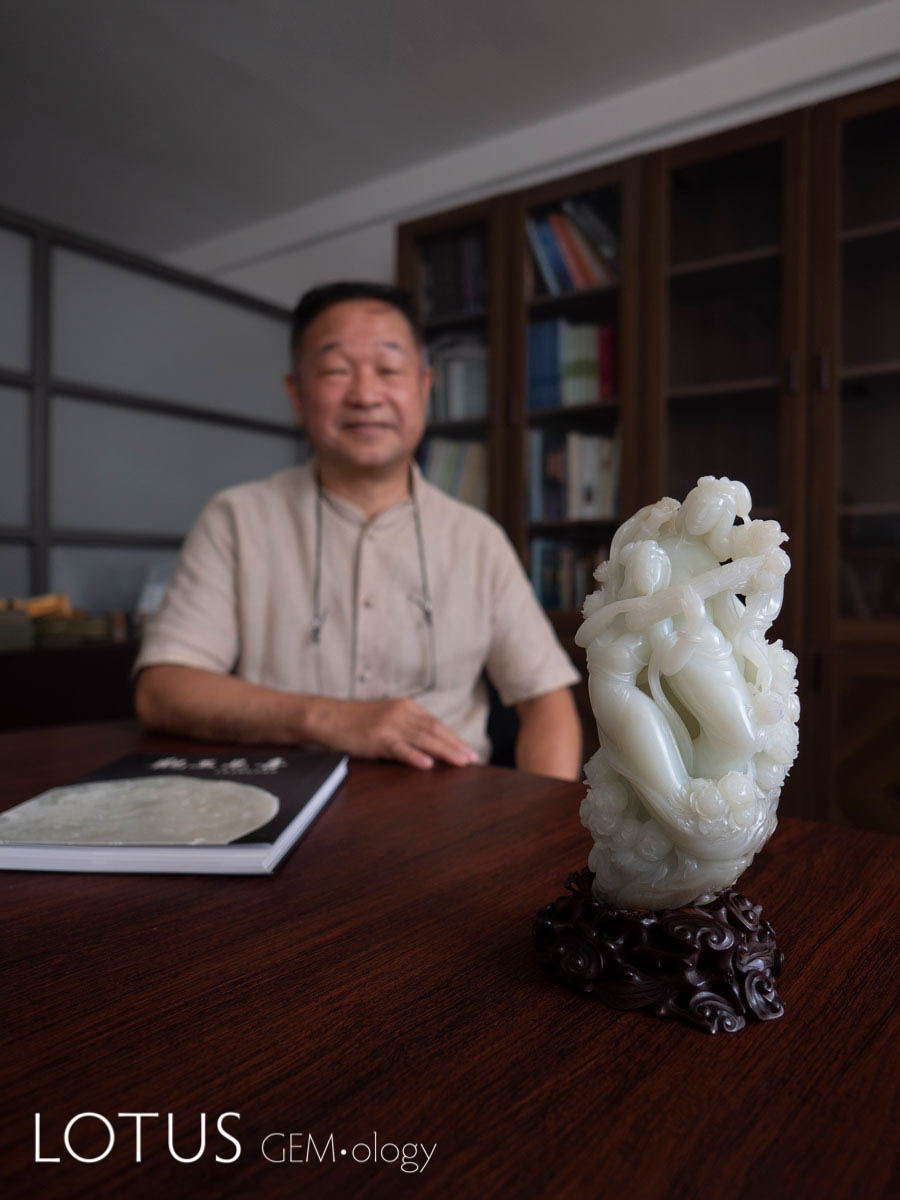 Lin Tze-Chuan with his book Joyful Forms of Beautiful Jade (2016), along with "Sing and Dance to Extol the Good Times" by Wu Desheng. This lovely carving depicts a beautiful lady dancing with peony blooms. The happy, heartfelt expression shows that she is grateful to live in a joyous era. Hetian "mutton fat" nephrite from Xinjiang, China; 10.1 x 20.7 x 6.5 cm.; 2008. Photo: Richard W. Hughes. Click on the photo for a larger image
Lin Tze-Chuan with his book Joyful Forms of Beautiful Jade (2016), along with "Sing and Dance to Extol the Good Times" by Wu Desheng. This lovely carving depicts a beautiful lady dancing with peony blooms. The happy, heartfelt expression shows that she is grateful to live in a joyous era. Hetian "mutton fat" nephrite from Xinjiang, China; 10.1 x 20.7 x 6.5 cm.; 2008. Photo: Richard W. Hughes. Click on the photo for a larger image
EBH—In the West, we normally defiine jade as either jadeite or nephrite, but in China jade is much more. How would you define jade?
LTC—Usually in the current standard way, jade is divided into two types: nephrite, represented by Hetian jade, and jadeite.
EBH—What is your favourite type of jade material? Jadeite, nephrite or something else?
LTC—My favourite is Hetian jade. The main reason is that Hetian jade works have the deepest cultural connection and the most complete inheritance of history and culture. Its decoration usually has unique connotative significance . With the development of contemporary jade art, Hetian jade carvings have also added more modern cultural creativity, showing more possibilities of artistic creation.
In addition, Hetian jade has important material characteristics. Its tight grain structure produces tremendous toughness. Thus, artists can carve delicate, more detailed lines. Hetian jade is also pure and simple in colour. It allows the creation of larger shapes, giving the space to express fully the craft. Some Hetian jades have unique textures/colours, such as black and white, which are suitable for creating specific works of art according to the individual material.
EBH—Are there any special beliefs surrounding jade in China?
LTC—For Chinese civilisation, jade is a comprehensive vehicle, which inherits the accumulation of history and culture. Through different historical periods, it has carried many meanings, such as sacrifice, power, prayer, education, and so on.
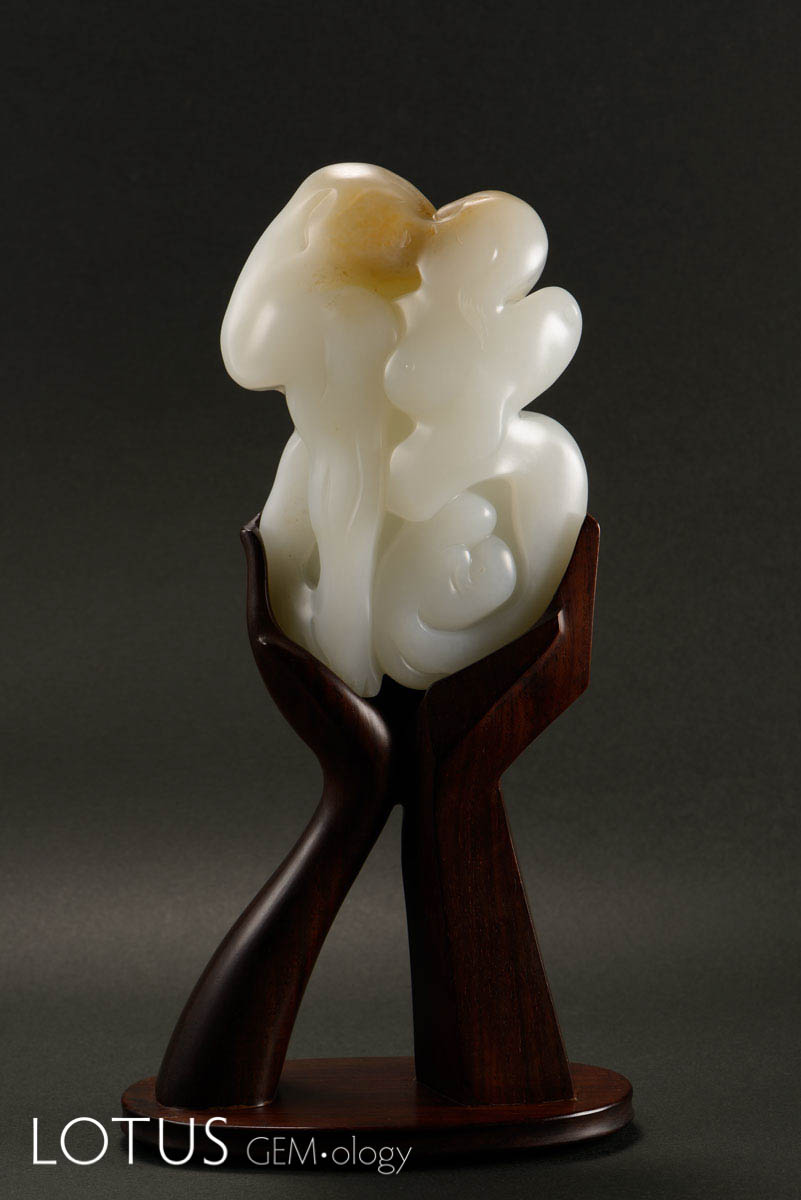 Blessing by Yu Jing. The front view is the Chinese character of "happiness" with a pattern culture. The pattern consists of a couple, in which the wife is pregnant with a child and expresses the happiest moment of a family. Hetian "mutton fat" nephrite from Xinjiang, China; 11.2 x 7.6 x 2.8 cm;1999. Photo: Zou Liu. Click on the photo for a larger image
Blessing by Yu Jing. The front view is the Chinese character of "happiness" with a pattern culture. The pattern consists of a couple, in which the wife is pregnant with a child and expresses the happiest moment of a family. Hetian "mutton fat" nephrite from Xinjiang, China; 11.2 x 7.6 x 2.8 cm;1999. Photo: Zou Liu. Click on the photo for a larger image
EBH—Some have called you the father of contemporary jade carving in China. Can you tell us about that journey? How did you meet the artists who would rise to prominence in this field?
LTC—I am just a manager in the jade carving industry, and I dare not bear that title. When I arrived in Shanghai in 1993, the state-owned jade carving factory was still the major unit, mainly used for earning foreign exchange. Jade carving products were also relatively standardised works. In order to meet the market needs of Taiwan and other overseas Chinese communities, I began to find jade carvers to work with, to explore and produce more novel works. Later, I continued to co-operate with different jade sculptors to create works of different styles.
The development of jade sculptors requires good people skills, such as communication and co-operation, as well as a good perception and understanding of art. In co-operating with artists, I respect their creativity, help them develop their own style, gradually forming a mature mode of communication with those who appreciate and purchase art.
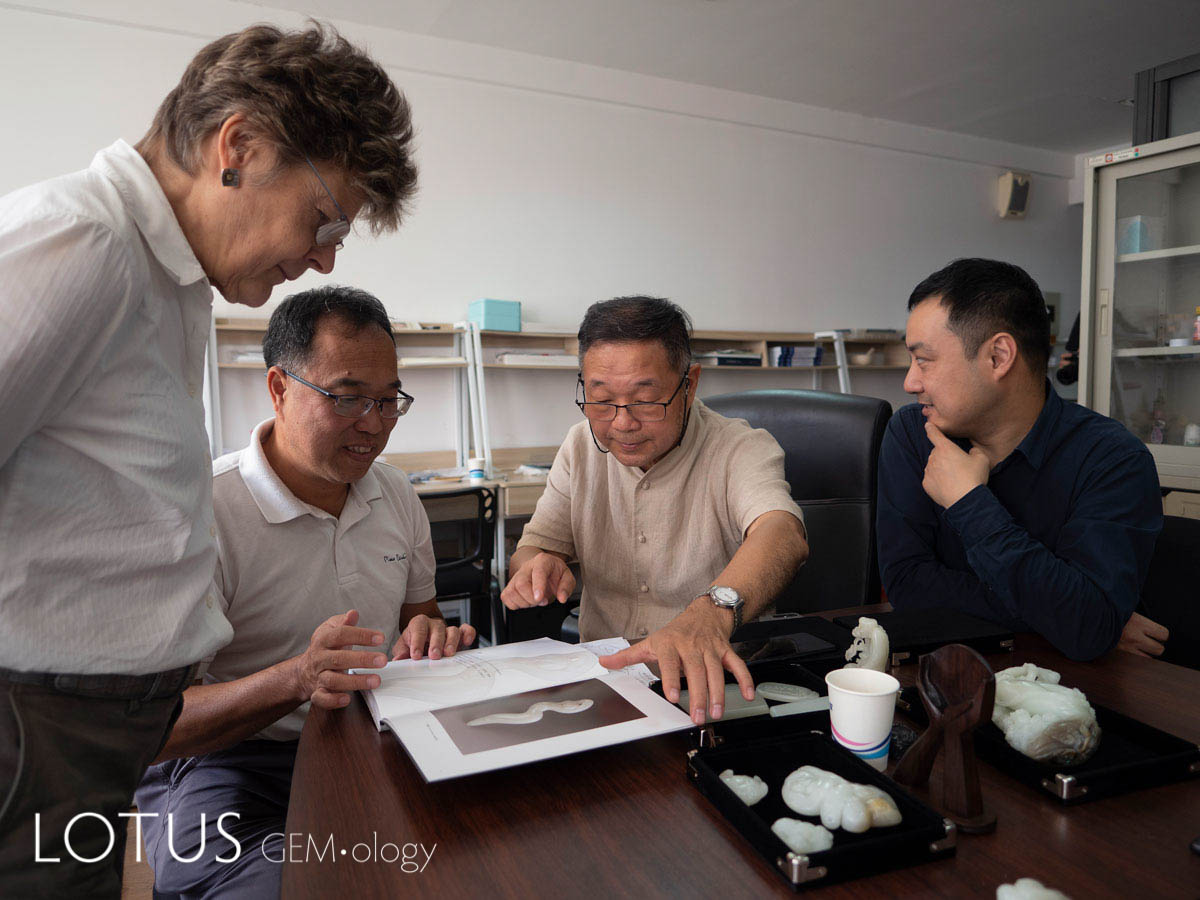 (Left to right) Margaret Sax of the British Museum, examining the jades pictured in Lin Tze-Chuan's book Joyful Forms of Beautiful Jade (2016), with Jason C.H. Kao, Lin Tze-Chuan and Zhou Zhengyu at Shanghai's Tongji Universiity. Tongji Professor Zhou Zhengyu has worked closely with the British Museum to bring contemporary Chinese jade carving to a wider audience. Photo: Richard W. Hughes. Click on the photo for a larger image
(Left to right) Margaret Sax of the British Museum, examining the jades pictured in Lin Tze-Chuan's book Joyful Forms of Beautiful Jade (2016), with Jason C.H. Kao, Lin Tze-Chuan and Zhou Zhengyu at Shanghai's Tongji Universiity. Tongji Professor Zhou Zhengyu has worked closely with the British Museum to bring contemporary Chinese jade carving to a wider audience. Photo: Richard W. Hughes. Click on the photo for a larger image
EBH—Jade carving in China goes back thousands of years, not unlike many Chinese art forms. What inspired you to attempt to bring a more contemporary direction to the field? Did you get resistance from the carvers, or where they also anxious to move in a new direction?
LTC—In the 1990s, while Chinese contemporary art had produced some new and profound works, jade carvings at that time were mainly copies of antique motifs. I began to think about potential new development directions in jade carving and how to produce work that would be representative of the modern era. So we tried to combine Chinese themes with Western expressions, and slowly explored new developments.
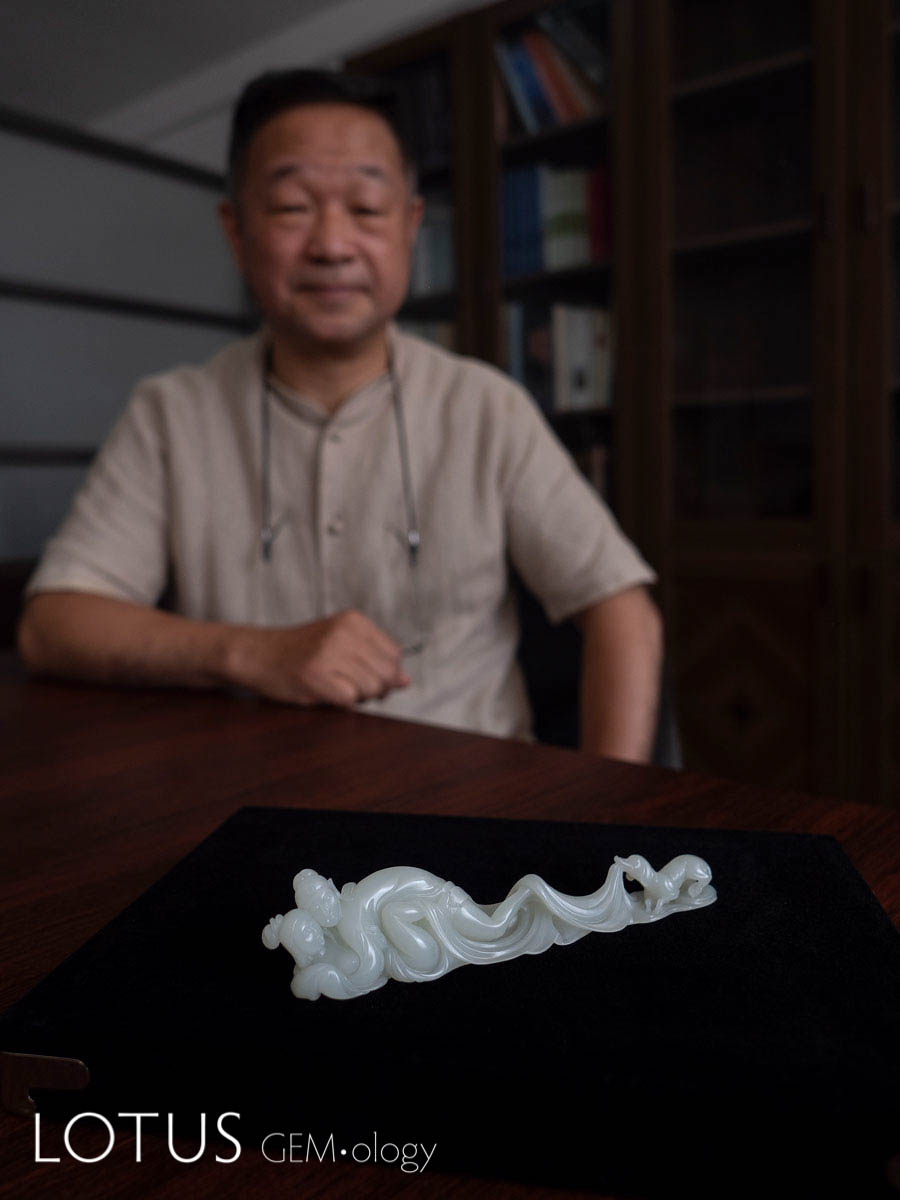 Erotic Pen Holder by Wu Desheng. This carving, which shows a couple's lovemaking interrupted by a dog, is a fantastic example of bringing humor and whimsy into the art form. Hetian "mutton fat" nephrite from Xinjiang, China. 15.2 x 2.3 x 3.3 cm; 2003. Photo: Richard W. Hughes. Click on the photo for a larger image
Erotic Pen Holder by Wu Desheng. This carving, which shows a couple's lovemaking interrupted by a dog, is a fantastic example of bringing humor and whimsy into the art form. Hetian "mutton fat" nephrite from Xinjiang, China. 15.2 x 2.3 x 3.3 cm; 2003. Photo: Richard W. Hughes. Click on the photo for a larger image
Jade sculptors initially resisted, because it required not just new motifs, but a new mode of thinking for them. They had not been exposed to the outside world and were also afraid of failure. However, for artistic creation, they also have the desire to express themselves. In order to dispel their worries, I provided them with creative raw materials and a relaxed artistic environment, reducing their economic pressure and risk, and encouraged them to explore new designs. I gave them space for free development. With constant adjustment and blending, carvers gradually developed their thoughts and language through the completion of one piece of work, progressively forming their own style.
EBH—How has modern technology changed jade carving?
LTC—Modern technology has promoted the motivation and the efficiency of jade carving creation, but the style and artistic effect have not changed greatly. The change in modern technology is reflected in people's understanding of tools and the effect of presentation. Development of modern jade carving mainly stems from the progress of thinking and culture.
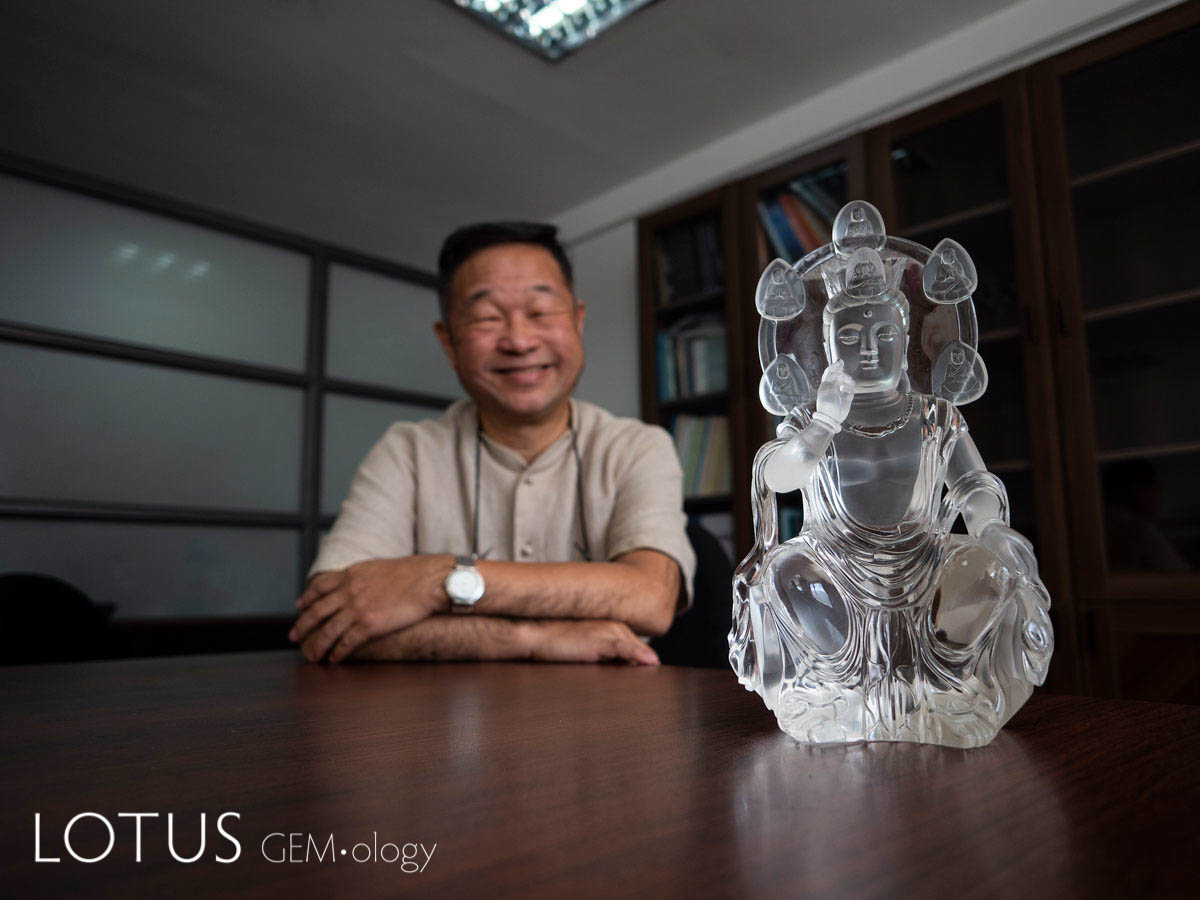 Maitreya Buddha by Liu Zhongrong. Rock crystal quartz. The most unusual feature of this work is that it adopts a special polishing technology, which is different from the common vitreous lustre of polished rock crystal and the common matte finish found in the market. This work uses melon sac as a polishing tool and produces a "transparent matte" effect. 1996. Photo: Richard W. Hughes. Click on the photo for a larger image
Maitreya Buddha by Liu Zhongrong. Rock crystal quartz. The most unusual feature of this work is that it adopts a special polishing technology, which is different from the common vitreous lustre of polished rock crystal and the common matte finish found in the market. This work uses melon sac as a polishing tool and produces a "transparent matte" effect. 1996. Photo: Richard W. Hughes. Click on the photo for a larger image
EBH—When we met in April 2019, you showed us jade carvings that you had commissioned to be made by machine. For many working in the field of fine arts, this is almost sacrilegious. Do you really believe that people will buy fine art made by machines?
LTC—I expect the acceptance of machine carvings to grow. The number of machine-carved products is increasing day by day, and now it comprises more than 50 percent of the market share of middle and low-end jade carving. In addition, many hand-carved works now also involve machine carving as a production step, according to the production needs of the work, combining machine carving with manual carving, using machine carving to create exquisite works.
The advantages of machine carving are speed, stability of the tools and the ability to create finer lines. As a result, the cost of machine-produced carvings is relatively low, with the price reduced by 50–70 percent compared with hand carvings. This can give more consumers access to exquisite jade carvings.
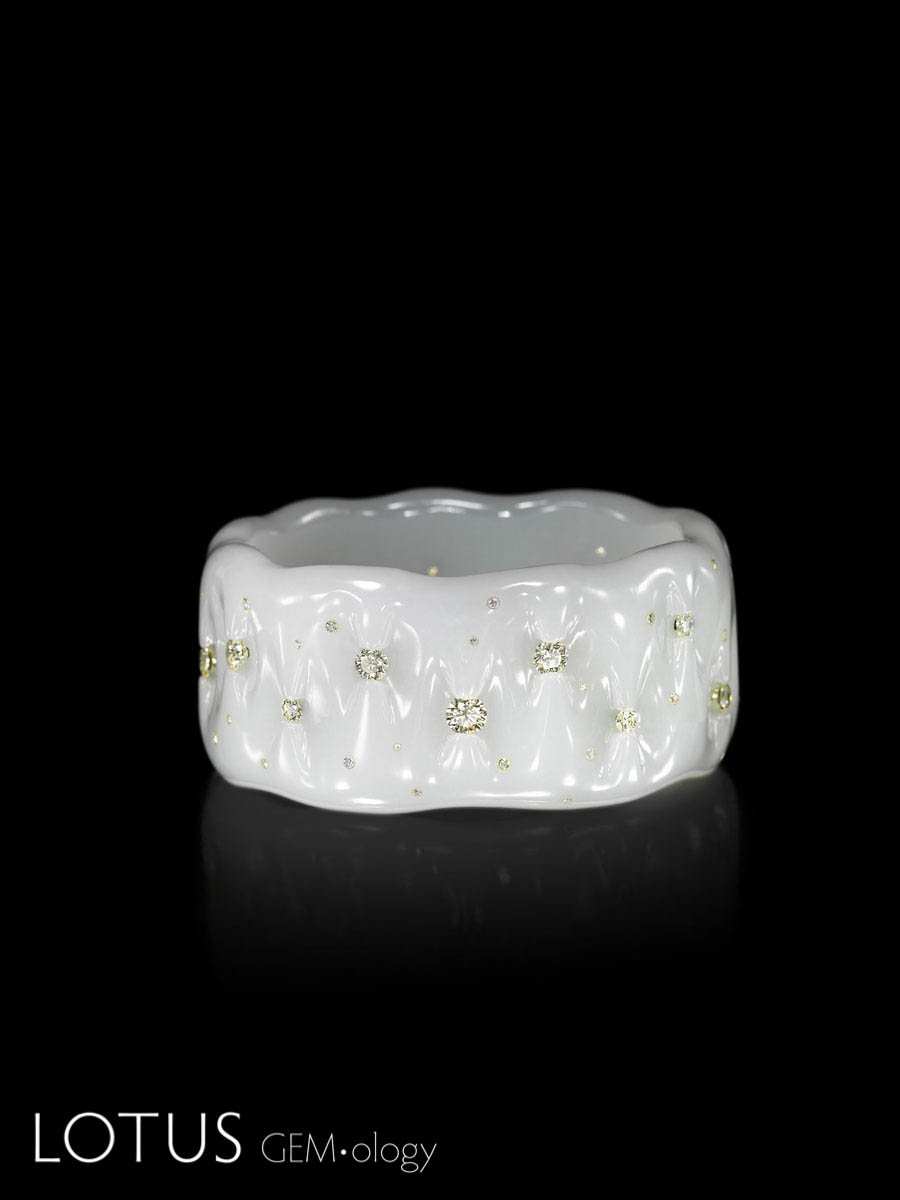 Tender is my Skin by Wallace Chan. Russian nephrite with diamonds. This piece uses an innovated carving technique to suspend diamonds in the bangle without having to us metal prongs. 7.8 x 6.8 x 3.4 cm.; 2015. Photo: Wallace Chan. Click on the photo for a larger image
Tender is my Skin by Wallace Chan. Russian nephrite with diamonds. This piece uses an innovated carving technique to suspend diamonds in the bangle without having to us metal prongs. 7.8 x 6.8 x 3.4 cm.; 2015. Photo: Wallace Chan. Click on the photo for a larger image
EBH—We also spoke of the high cost of rough jade today, and how this made it so difficult for young carvers to work in jade. Can you share your thoughts on this? Should young carvers look to make their mark using other materials?
LTC—I think the high price of raw materials is an important factor hindering the creation of Hetian jade works, which limits artistic creation and market circulation. High prices will make sculptural artists more cautious about the creation of their art. This creates a lot of limitations, as it is difficult for them to experiment with new possibilities.
Jade sculptors should experiment with other materials. This will require them to have a better understanding of the characteristics of materials and the artistic effects that materials can show, and to dare to try different possibilities.
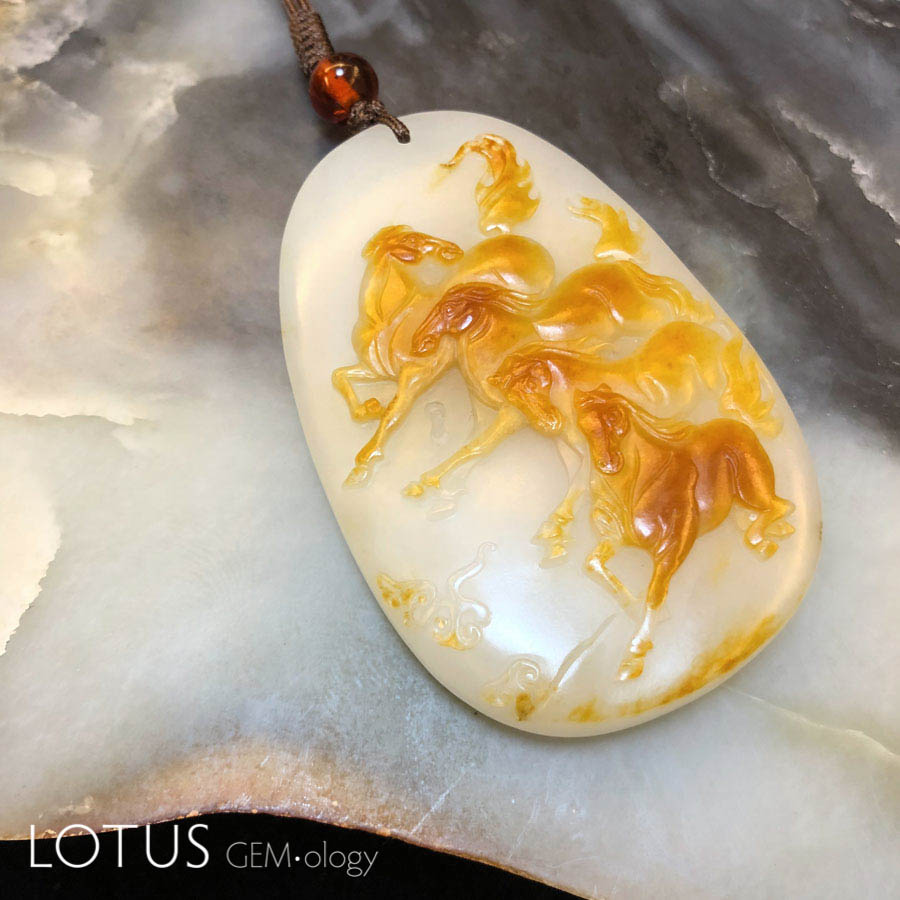 Horses from Heaven by Lu Kaifei. The carver has skillfully used the natural staining of the Hetian "mutton fat" nephrite jade. 7.7 x 4.9 x 1.35 cm; 2008. Photo: E. Billie Hughes. Click on the photo for a larger image
Horses from Heaven by Lu Kaifei. The carver has skillfully used the natural staining of the Hetian "mutton fat" nephrite jade. 7.7 x 4.9 x 1.35 cm; 2008. Photo: E. Billie Hughes. Click on the photo for a larger image
EBH—Do you have a favorite piece of jade in your collection?
LTC—There are three works I like best:
Yu Jing's Mutual Respect is one of the most accurate works in the proportion of the structure of jade carving figures. Because of his use of detail and life-like facial expressions, we can feel the actual volume and body movements of the human physique.
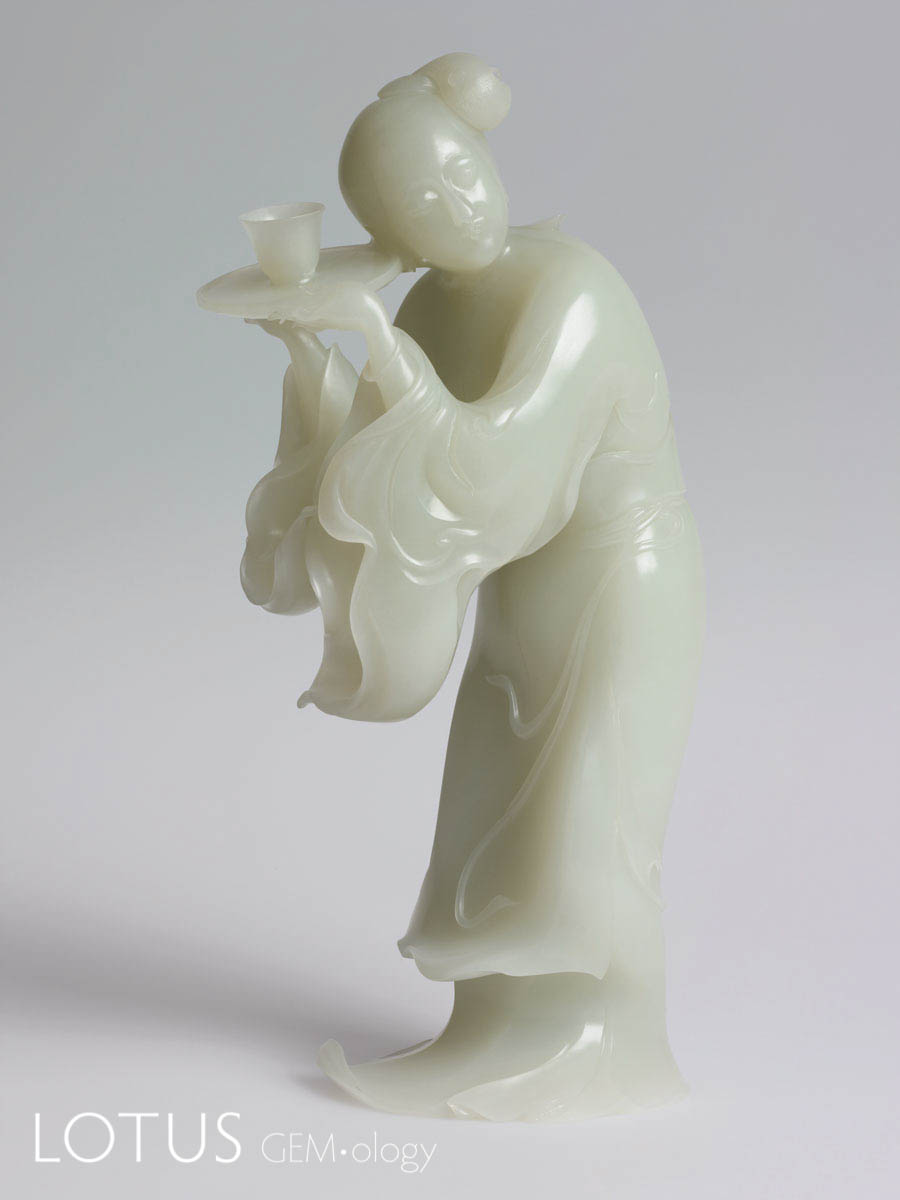 Mutual Respect by Yu Jing. Hetian "mutton fat" nephrite from Xinjiang, China. This piece is remarkable for the high-quality of the jade used, but also for the position of the figure, which necessitated a huge amount of material wastage. Most carvers would never dare to waste so much expensive rough jade. 20 x 8.9 x 5.9 cm; 2002. Photo: Huang Guojun. Click on the photo for a larger image
Mutual Respect by Yu Jing. Hetian "mutton fat" nephrite from Xinjiang, China. This piece is remarkable for the high-quality of the jade used, but also for the position of the figure, which necessitated a huge amount of material wastage. Most carvers would never dare to waste so much expensive rough jade. 20 x 8.9 x 5.9 cm; 2002. Photo: Huang Guojun. Click on the photo for a larger image
Wu Desheng's Beauty on the Beach uses black and white materials properly and has strong visual senses.
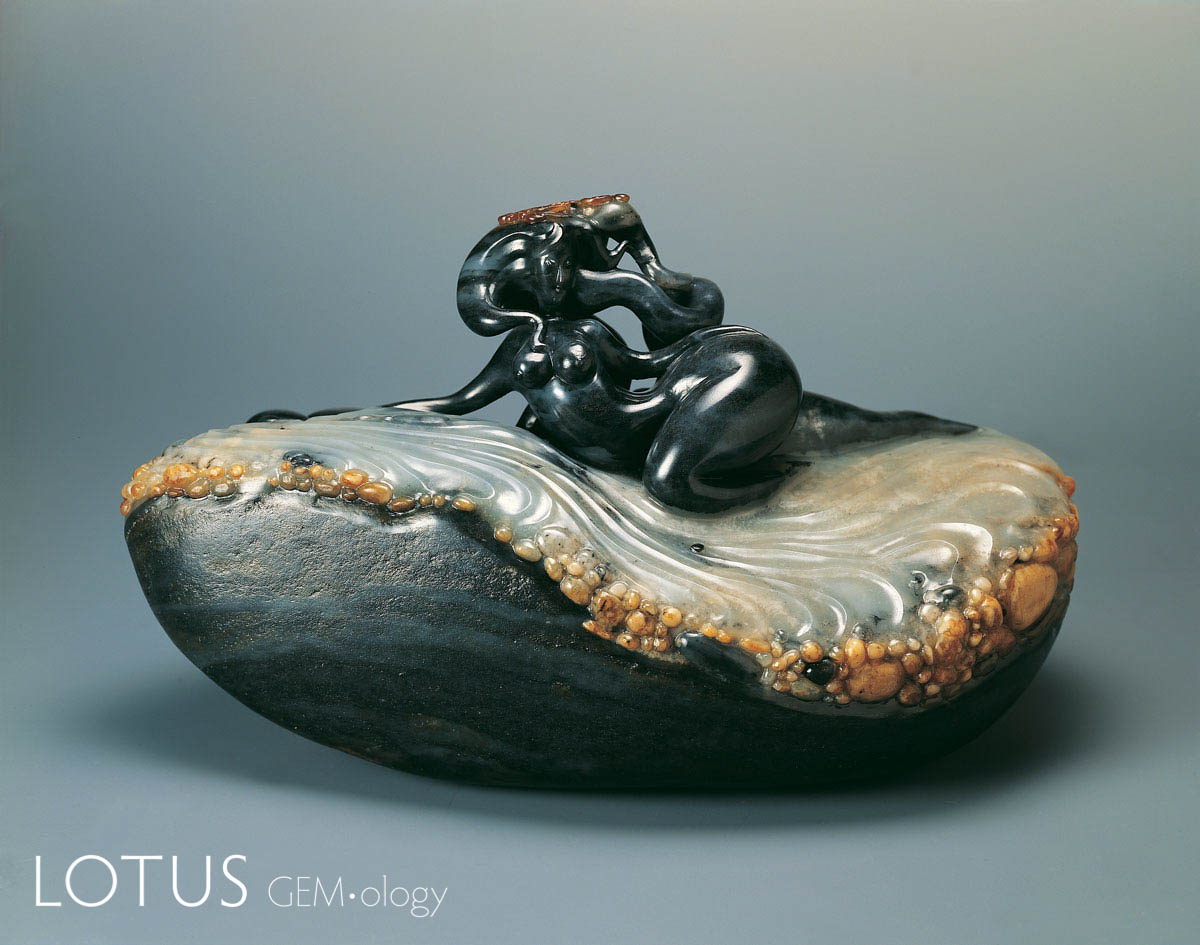 Beauty on the Beach by Wu Desheng. This carving, which is done in nephrite jade from Xinjiang, China (Hetian jade), is an exceptional example of a master carver using the variations in both texture and color of the jade itself to create something transcendent. 19.5 x 11.5 x 9.5 cm; 2006. Photo: Zou Liu. Click on the photo for a larger image
Beauty on the Beach by Wu Desheng. This carving, which is done in nephrite jade from Xinjiang, China (Hetian jade), is an exceptional example of a master carver using the variations in both texture and color of the jade itself to create something transcendent. 19.5 x 11.5 x 9.5 cm; 2006. Photo: Zou Liu. Click on the photo for a larger image
Wu Desheng's Boat with Dark Awning skilfully uses the essence and weathered skin of the jade. The different techniques of jade carving are embodied in this work to create a unique overall shape.
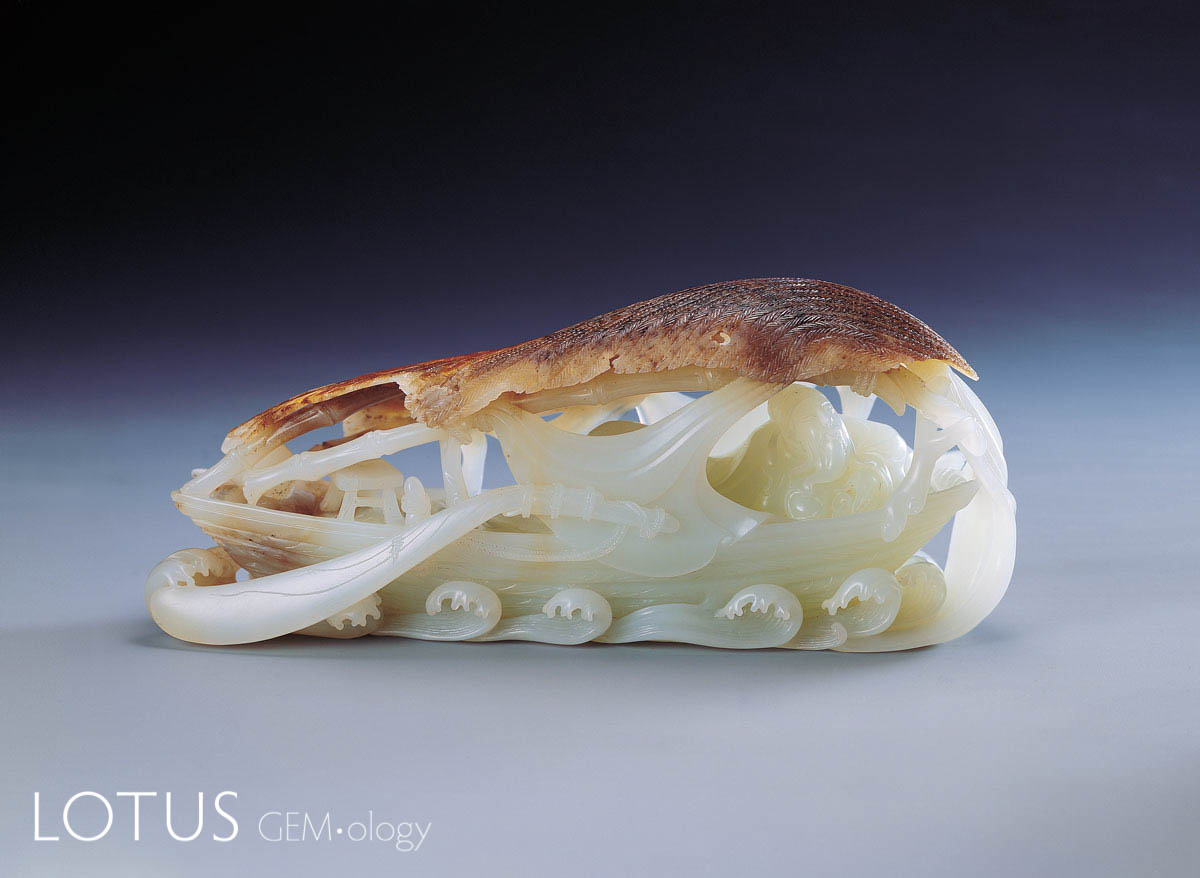 Boat with Dark Awning by Wu Desheng. The weathered skin on the surface of the jade is skilfully used to carve the dark awning on the top of the ship. The boat depicts the scenes of Li Bai, a famous poet of Tang Dynasty, drinking and writing poems. Hetian "mutton fat" nephrite from Xinjiang, China; 17.5 x 8 x 5.5 cm; 2007. Photo: Zou Liu. Click on the photo for a larger image
Boat with Dark Awning by Wu Desheng. The weathered skin on the surface of the jade is skilfully used to carve the dark awning on the top of the ship. The boat depicts the scenes of Li Bai, a famous poet of Tang Dynasty, drinking and writing poems. Hetian "mutton fat" nephrite from Xinjiang, China; 17.5 x 8 x 5.5 cm; 2007. Photo: Zou Liu. Click on the photo for a larger image
EBH—How can collectors determine if a piece is high quality?
LTC—A high-quality work of art will directly touch the viewer's mood and make the viewer feel the artistic ideas and connotations that the artist wishes to express. Different collectors will have their own unique understanding of art in pursuit of art, while beauty is intuitive and will penetrate into the hearts of people at the moment of contact.
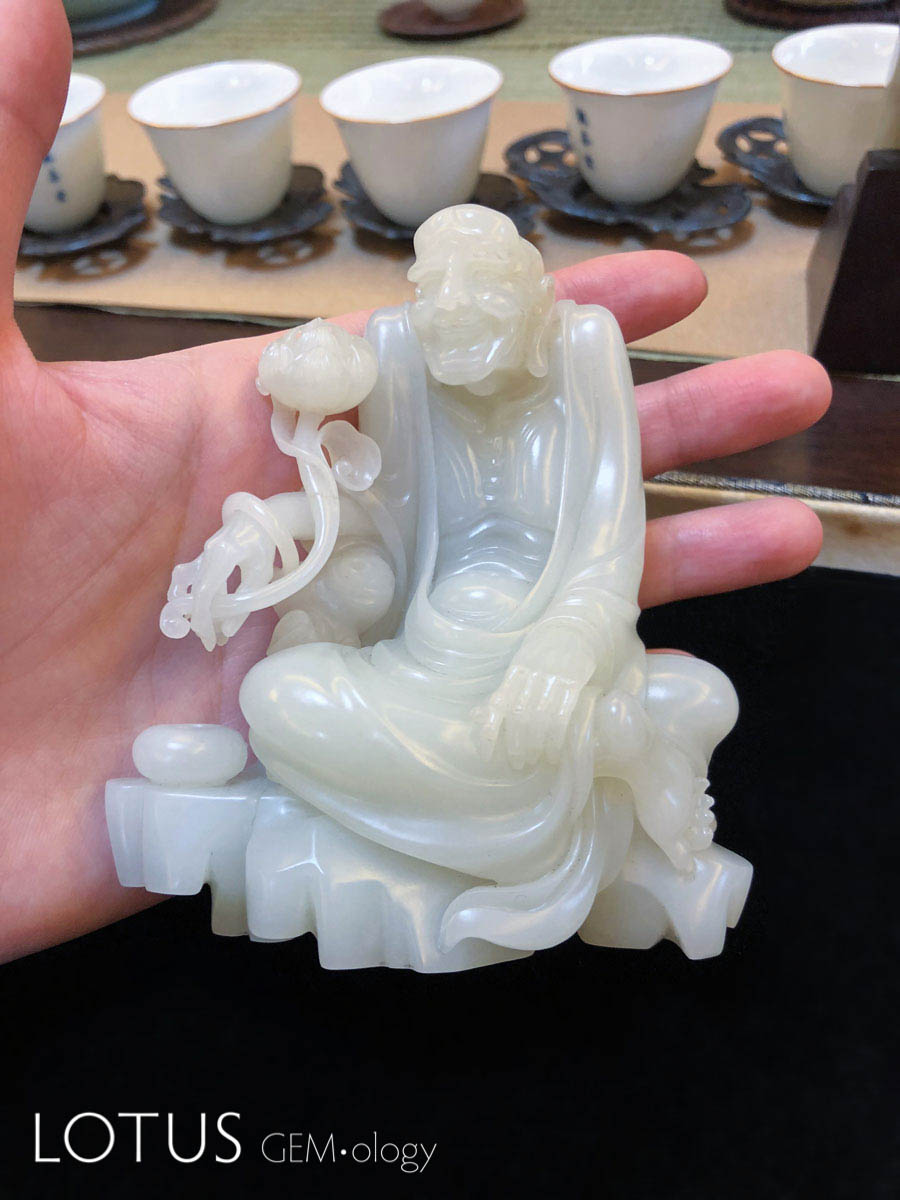 Sixteenth Arhat by Wu Desheng. Wu Desheng told the author (EBH) that intricate figures such as this (complete with rotatable jade bangle bracelet) are exceedingly difficult to carve. Hetian "mutton fat" nephrite from Xinjiang, China. 10.4 x 9.35 x 5.2 cm; 2003. Photo: E. Billie Hughes. Click on the photo for a larger image
Sixteenth Arhat by Wu Desheng. Wu Desheng told the author (EBH) that intricate figures such as this (complete with rotatable jade bangle bracelet) are exceedingly difficult to carve. Hetian "mutton fat" nephrite from Xinjiang, China. 10.4 x 9.35 x 5.2 cm; 2003. Photo: E. Billie Hughes. Click on the photo for a larger image
EBH—Who do you believe are the most talented jade carvers today?
LTC—Nowadays, there are many excellent jade sculptors, such as Chen Shiying, Wu Desheng, Yu Jing and so on.
.jpg) Lin Tze Chuan (Lin Zi Quan) in his Shanghai studio, displaying six carvings by Wu Desheng, featured in the book Extraordinary and Elegant (2007). The twelve zodiac animals corresponding to the twelve terrestrial branches; all the zodiac signs have absorbed elements of Chinese opera and are personalized. Hetian "mutton fat" nephrite from Xinjiang, China. 2007. Photo: E. Billie Hughes. Click on the photo for a larger image
Lin Tze Chuan (Lin Zi Quan) in his Shanghai studio, displaying six carvings by Wu Desheng, featured in the book Extraordinary and Elegant (2007). The twelve zodiac animals corresponding to the twelve terrestrial branches; all the zodiac signs have absorbed elements of Chinese opera and are personalized. Hetian "mutton fat" nephrite from Xinjiang, China. 2007. Photo: E. Billie Hughes. Click on the photo for a larger image
EBH—Despite the abundance of historic jades in American and European museums, connoisseurship of jade has remained almost exclusively an East Asian phenomenon. Do you think this is changing?
LTC: Jade carving is a unique form of artistic expression in China. Because its creation is focused on Chinese aesthetics, it requires aficionados to know more about Chinese history and culture. With the increasing world attention on Chinese culture, this situation is changing slowly. I expect the interest in Chinese jade carving culture to increase going forward.
EBH—Has China done enough to publicise their carving skills to the outside world?
LTC—I don't think we have done enough. Modern jade carving art is still in its infancy, and it still has a lot of room for growth. Jade art needs to be seen by more viewers, and more efforts are needed to export this art beyond our national boundaries. This could be done by supporting exhibitions, publicity, marketing, etc.
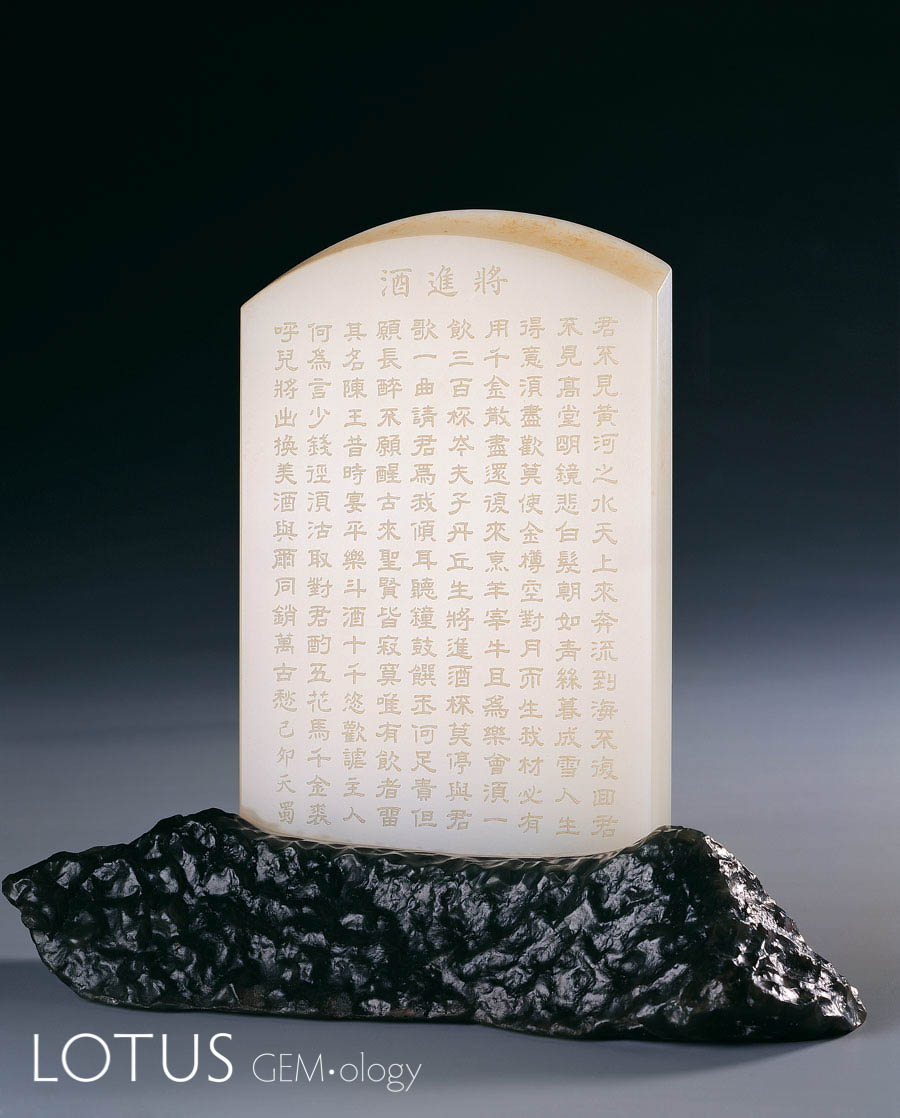 Chinese drinking song engraved on Hetian "mutton fat" nephrite jade sits atop a base of naturally weathered ('Gobi') nephrite jade. Carving by Yi Shaoyong. 7.7 x 11.6 x 1 cm; 1999. Photo: Zou Liu. Click on the photo for a larger image
Chinese drinking song engraved on Hetian "mutton fat" nephrite jade sits atop a base of naturally weathered ('Gobi') nephrite jade. Carving by Yi Shaoyong. 7.7 x 11.6 x 1 cm; 1999. Photo: Zou Liu. Click on the photo for a larger image
EBH—How might this impact the jade industry if jade became popular around the world, instead of just in China?
LTC—Due to the limitations of jade materials, cultural aesthetics and industrial scale, it is difficult spread this information in a short time.
On one hand, the spread of jade culture outside of China would stimulate the development of the carving industry, allowing the production of more exquisite works, and also help consumers around the world to better understand the existing price system of jade carving; on the other hand, jade carving is a relatively small industry with a limited production scale. Blind expansion will produce mixed works, which is not conducive to industrial development.
EBH—Where do you see jade (and other hard stone) art moving in twenty years, fifty years or 100 years from now?
LTC—Future trends are hard to predict. Social factors undergo constant change and the age levels of jade carvers and consumers are also in flux. In addition, the art of modern jade carving is still in the “initial stage”; this creates more uncertainty; thus the development trend is not clear.

Ackknowledgements
The author would like to thank Zhou Zhengyu (征宇 周) of Shanghai's Tongji University for translation assistance, and especially for sharing his knowledge of Chinese jade with her.
Notes
This article was first published in Arts of Asia magazine (2020; Vol. 50, No. 3, May–June, pp. 103–108). The entire issue is devoted to jade and is a wonderful collector's item.
References
-
皮楚榮, ed. (2016) 觀玉見喜: 上海玉展紀念專輯 [Joyful Forms of Beautiful Jade]. www.guanxitangart.com, 193 pp.; RWHL.
About the author
E. Billie Hughes visited her first gem mine (in Thailand) at age two and by age four had visited three major sapphire localities in Montana. A 2011 graduate of UCLA, she qualified as a Fellow of the Gemmological Association of Great Britain (FGA) in 2013. An award winning photographer and photomicrographer, she has won prizes in the Nikon Small World and Gem-A competitions, among others. Her writing and images have been featured in books, magazines, and online by Forbes, Vogue, National Geographic, and more. In 2019 the Accredited Gemologists Association awarded her their Gemological Research Grant. Billie is a sought-after lecturer and has spoken around the world to groups including Cartier and Van Cleef & Arpels. In 2020 Van Cleef & Arpels’ L’École School of Jewellery Arts staged exhibitions of her photomicrographs in Paris and Hong Kong.

